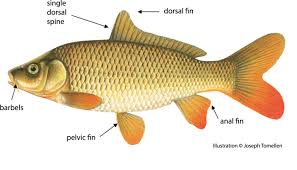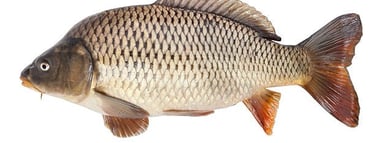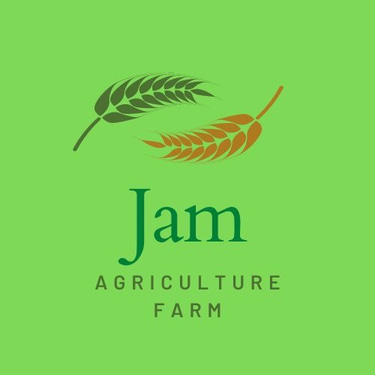Common carp Gulfam fish farming
It is a fast growing omnivore’s fish. It can easily adapt themselves to changing environmental conditions so it can be reared in both hot and cold areas of the world. It has flat body, round stomach, wide face which turns down, thick and large cane, dark gray color body having sides golden yellow in color.
FISH FARMING
Common Carp (Gulfam) Farming
Common carp live in the middle and lower streams of rivers and in shallow waters, such as lakes, oxbow lakes, and water reservoirs. Carp are mainly bottom dwellers but search for food in the middle and upper layers of the water body. Typical 'carp ponds' are shallow, eutrophic ponds with a muddy bottom and dense aquatic vegetation at the dikes. The ecological spectrum of carp is broad. Best growth is obtained when the water temperature ranges between 23 °C and 30 °C. The fish can survive cold winter periods. Salinity up to about five per cent is tolerated. The optimal pH range is 6.5-9.0. The species can survive low oxygen concentrations (0.3-0.5 mg/litre) as well as supersaturation. Carps are omnivorous, with a high tendency towards the consumption of animal food, such as water insects, larvae of insects, worms, molluscs, and zooplankton. Additionally, the carp consumes the stalks, leaves and seeds of aquatic and terrestrial plants, decayed aquatic plants, etc. The daily growth of carp can be 2 to 4 per cent of body weight. Carps can reach 0.6 to 1.0 kg body weight within one season in the polyculture fish ponds of subtropical/tropical areas.
It is a fast-growing omnivore fish. It can easily adapt itself to changing environmental conditions so it can be reared in both hot and cold areas of the world. It has a flat body, round stomach, wide face which turns down, thick and large cane, the dark grey colour body having sides golden yellow in colour. The dorsal fin with 17-21 rays and the anal fin both have a heavy-toothed spine. These fishes have an average body length of 12-24 inches although they can grow much larger. It feeds deep down the water surface and feeds upon weeds and organic wastes. These fishes lay eggs in the months of January to March. This fish lay eggs ranging from 80,000-1,00,000 eggs depending upon their body weight. Approximately 4000 common carp fish can be reared in per acre space. It grows well when the water temperature is 18-20 C. If the fingerling having a weight of 25-50g is stocked, then depending upon the conditions in 2-3months it attains the weight of 200-300g, in 5-7months it attains the weight of 1-1.2kg and in 10-14months it attains the weight of 2.5-3.5kg.
Feed
Artificial diet: Normally artificial fish feed is available in the markets. To make the feed hard Carboxy methyl cellulose or gelatin is added and then it is thinly crushed and prepared into pellets. It is healthy but it can’t be stored for a long time. It contains 8-11% of moisture content. The dry pellet is of two types, one is a sinking type and the other is a floating type.
Protein: Mainly different breeds of fish require a different amount of protein level in their diet.
Lipids: n-3 HUFA is required in the diet as a lipid for the optimal growth and health of marine fishes.
Carbohydrates: About 20% of carbohydrates are required in fish feed. Feed types: There are two types of feed available i.e. floating and sinking feed. Different breeds of fish prefer different feeds for example shrimp will only eat shrinking feed. Feed is available in the form of pellets ranging in different sizes according to the size of the fish.
Medicated feeds: Medicated feeds are used when fish stops eating the feed or fall ill. Medicated feeds are used to cure fish of diseases.
Fish seed production
Broodfish are kept in water saturated with oxygen, within the temperature range of 20-24 ºC. They are given two doses of pituitary gland injection, or a mixture of GnRH/dopamine antagonists, to induce ovulation and spermiation. The eggs are fertilized and the adhesiveness of the eggs is eliminated using salt/urea treatment, followed by a tannin acid bath. Incubation is carried out in Zoug jars. The hatched fry are kept in large conical tanks for 1 to 3 days and are usually stocked at the stage of 'swim-up' or 'feeding fry' into properly prepared ponds. Approximately 300,000 to 800,000 newly hatched fry can be expected from a single female.
Asian strains start to spawn when the ion concentration of the water decreases abruptly at the beginning of the rainy season. Wild carps are partial spawners. Domesticated carps release all their matured eggs within a few hours. After hormonal treatment carp release their ripe eggs within a much shorter period, which makes stripping possible. The quantity of released eggs is 100 to 230 g/kg body weight. The eggshell becomes sticky after contacting water. The embryonic development of carp takes about 3 days at 20-23 °C (60-70 degree-days). Under natural conditions, hatched fry sticks to the substrate. About three days after hatching the posterior part of the swim bladder develops, the larvae swim horizontally and start to consume external food with a maximum size of 150-180 µm (mainly rotifers).
Fingerling production
The production of carp fingerlings normally takes place in semi-intensive ponds, based on manure/fertilizer-generated natural food and supplementary feeding. Fingerling production can be carried out in a single-stage system (stocking newly hatched fry and harvesting fingerlings), a dual-stage system (stocking nursed fry and harvesting fingerlings), or a multicycle system (when newly hatched fry are stocked, and the fish are thinned out several times).
Care and shelter
Land which is not good for agriculture is used to make fish farm. For fish farms some points should be kept in mind such as the land should have water holding capacity, and don’t make a pond on sandy and loamy soil. If you want to do soil testing then at that land dig 1 foot-wide and deep hole and fill it with water. If the water remains in the hole for 1-2 days then it is good for fish farming but if no water remains in the hole then it is not good for fish farming. Mainly 3 types of ponds are there i.e. Nursery pond, Rearing pond and Production pond.
Fertilizer management
Mainly organic and inorganic fertilizers are used in aquaculture.
Inorganic or mineral fertilizers: It contains mineral nutrients which are manufactured in industries and material is taken from agricultural fields. It includes animal manure, chicken manure and some other organic materials. Organic materials such as composts, grass, sewage, and rice bran.
Organic fertilizers: It contains a mixture of both mineral nutrients and organic matter. It is manufactured by the local people, which includes farm animal waste and agriculture waste. It consists of at least one of these nutrients such as nitrogen, phosphorus and/or potassium.
Care of baby fish
Remove the fish from the adult fish tank with the help of a scoop or cup. Baby fish must be given a few drops of infusoria which is a liquid diet with the help of an eyedropper several times a day. After some days when they reach half an inch in size, it is placed in the new tank which has enough space for them to grow.
Diseases
Tail and fin rot: The symptoms are rotting of the tail and fin, light white colour is seen at the corner of the fin, and then spread all around the fin and then finally falls.
Gill rot: The symptoms are grey colour gills and then they finally fall. The breath of fish will squeeze and they come at the upper layer of water to take the breath
White spot disease: White patches are seen on the skin, gills and fins of the fish.
Black spot disease: Small spots of black colour are seen on the body.
Argulosis: The symptoms are slow growth, loose fin and blood spots on the skin.
Leech: The symptoms are wounded skin and gills.
Vibriosis: The symptoms are white or grey colour lesions found on the spleen and intestines.
Furunculosis: The symptoms are darkening of the skin, enlarged spleen, rapid breathing and bloody mucous. This disease will increase mortality among fish.
Red mouth disease: The symptoms are reddening of fins, mouth, throat and gill tips
Market-size fish
Common carp can be produced in extensive, natural food and supplementary feed-based monocultural production systems, in stagnant water ponds. Common carp are stocked with Chinese carp, and/or Asian major carp, tilapia, mullet, etc., in polyculture systems. This constitutes a natural food and supplementary feed-based production method, in which fish that have different feeding habits and occupy different trophic niches are stocked into the same ponds. The quantity of fish should be in accordance with the productivity of natural food organisms. The frequent application of manure or fertilizers and the proper species ratio, make the maintenance of productive populations of natural food organisms, and the maximal utilization of the productivity of the pond ecosystem possible. Synergetic effects between fish species support the production in polyculture ponds.
Harvesting
Since the carp keep mud-free in the area where they search for food, feeding should be done throughout the growing period in the harvest area. At harvest time the water should be drained slowly. The fish gather in the deepest area of the pond unless they are frightened away by an abrupt decrease in water level, or by noises. Since carp tend to swim towards incoming water, a small quantity of water is flowed into the pond near the drainage site to concentrate the fish, especially if the water temperature is high. When a large quantity of fish is concentrated in the harvesting pits aeration should be supplied. Sprinkling water on the surface is usually not sufficient. Partial harvesting increases the total production of the ponds by improving the conditions for the remaining population.
Handling and processing
If harvesting is carried out in warm water, the fish are pre-conditioned by repeated stressing before netting. Harvested fish can be transferred live in aerated tanks for 3-5 hours if the fish/water ratio is not more than 1:2. The density of fish in transport tanks and the duration of transport depends on fish size, temperature and the amount of aeration. If during harvesting, fish have been enticed into the harvesting area by feed, only a very short transport time is feasible, since the oxygen demand of satiated fish is high. The majority of carp is transferred live to markets and is sold either live or freshly dressed. Apart from value-added products, about 15 different products can be prepared from carp, representing different levels of processing.
Conclusion
Common Carp are economically significant and many people are doing this business full-time. Fish farming is a good source of employment for rural youth. Normally the carp are raised in mud ponds but now people are growing these fish in tanks and biofloc technology.




